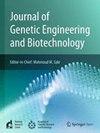Whole exon screening of SLC2A4 gene and the association of rs5435 with type 2 diabetes in a Bangladeshi case-control study
IF 2.8
Q3 Biochemistry, Genetics and Molecular Biology
Journal of Genetic Engineering and Biotechnology
Pub Date : 2025-07-10
DOI:10.1016/j.jgeb.2025.100534
引用次数: 0
Abstract
Type 2 diabetes (T2D) is a multifaceted disease influenced by both genetic and environmental factors, posing significant global health challenges. Polymorphisms in the SLC2A4 gene encoding the glucose transporter 4 (GLUT4), have been linked to insulin resistance and T2D. This study, therefore, aims to identify and analyze genetic variants within the SLC2A4 gene and determine their association with T2D risk through a Bangladeshi case-control study. A total of 239 individuals were enrolled in the study, including 127 T2D patients and 112 controls. All 11 exons of the SLC2A4 gene were sequenced in 20 individuals. Exons 2, 3, 4, and 5 of GLUT4 were then sequenced in an additional 99 participants. For the remaining 120 participants, a TaqMan probe-based RT-PCR was conducted to genotype rs5435. Four genetic variants were initially identified, including one synonymous variant (rs5435) in exon 4. There was no significant difference in the allele frequency of the wild-type allele T and variant allele C between the two groups (OR: 1.31, p = 0.13). Genotypic distribution revealed that individuals who were either heterozygous or homozygous for the variant allele are at an increased risk for developing T2D compared to those who are homozygous for the non-risk allele (p = 0.042), suggesting that the SNP could be considered to have a dominant effect on the likelihood of developing T2D. Additionally, in silico analysis revealed that the rs5435 variant introduces an additional loop in the mRNA secondary structure, which is energetically less stable and therefore may interfere with the protein’s biological function and play a role in the pathogenesis of T2D. However, further studies with larger cohorts are necessary to validate the impact of rs5435 on the risk of T2D in our population.
孟加拉国病例对照研究SLC2A4基因全外显子筛选及rs5435与2型糖尿病的关系
2型糖尿病(T2D)是一种受遗传和环境因素影响的多方面疾病,对全球健康构成重大挑战。编码葡萄糖转运蛋白4 (GLUT4)的SLC2A4基因多态性与胰岛素抵抗和T2D有关。因此,本研究旨在通过孟加拉国的病例对照研究,识别和分析SLC2A4基因内的遗传变异,并确定其与T2D风险的关系。共有239人参加了这项研究,其中包括127名T2D患者和112名对照组。对20个个体的SLC2A4基因的全部11个外显子进行了测序。然后对另外99名参与者的GLUT4外显子2、3、4和5进行测序。对其余120名参与者,采用基于TaqMan探针的RT-PCR对rs5435基因型进行分型。最初鉴定出4个遗传变异,包括外显子4中的一个同义变异(rs5435)。两组间野生型等位基因T和变异型等位基因C的等位基因频率差异无统计学意义(OR: 1.31, p = 0.13)。基因型分布显示,变异等位基因杂合或纯合的个体与非风险等位基因纯合的个体相比,患T2D的风险增加(p = 0.042),这表明该SNP可能被认为对患T2D的可能性具有显性影响。此外,硅分析显示,rs5435变体在mRNA二级结构中引入了一个额外的环,该环能量不稳定,因此可能干扰蛋白质的生物学功能,并在T2D的发病机制中发挥作用。然而,还需要更大规模的进一步研究来验证rs5435对人群中T2D风险的影响。
本文章由计算机程序翻译,如有差异,请以英文原文为准。
求助全文
约1分钟内获得全文
求助全文
来源期刊

Journal of Genetic Engineering and Biotechnology
Biochemistry, Genetics and Molecular Biology-Biotechnology
CiteScore
5.70
自引率
5.70%
发文量
159
审稿时长
16 weeks
期刊介绍:
Journal of genetic engineering and biotechnology is devoted to rapid publication of full-length research papers that leads to significant contribution in advancing knowledge in genetic engineering and biotechnology and provide novel perspectives in this research area. JGEB includes all major themes related to genetic engineering and recombinant DNA. The area of interest of JGEB includes but not restricted to: •Plant genetics •Animal genetics •Bacterial enzymes •Agricultural Biotechnology, •Biochemistry, •Biophysics, •Bioinformatics, •Environmental Biotechnology, •Industrial Biotechnology, •Microbial biotechnology, •Medical Biotechnology, •Bioenergy, Biosafety, •Biosecurity, •Bioethics, •GMOS, •Genomic, •Proteomic JGEB accepts
 求助内容:
求助内容: 应助结果提醒方式:
应助结果提醒方式:


